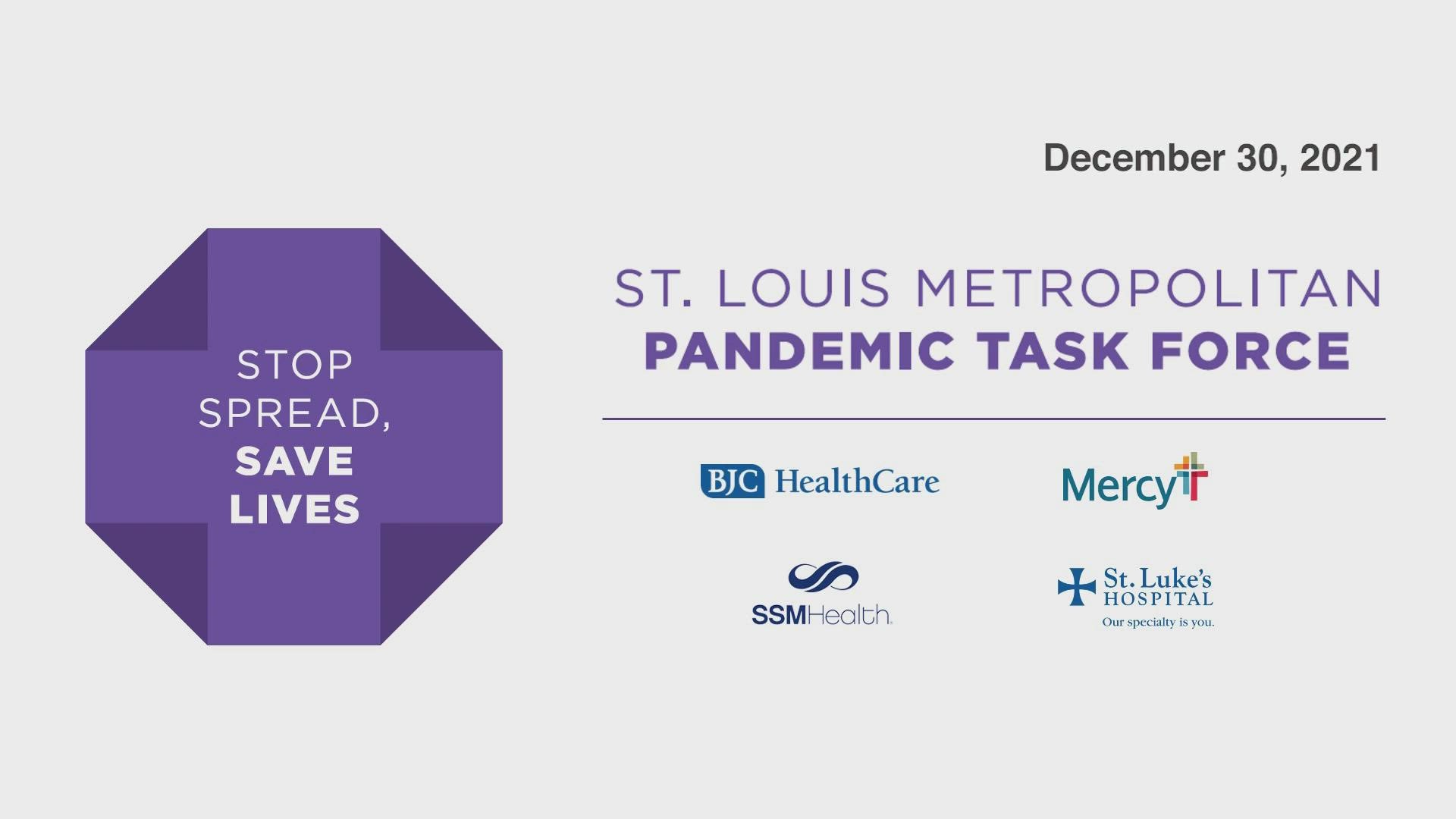ST. LOUIS — The St. Louis Metropolitan Pandemic Task Force held an unplanned briefing Thursday to provide an update on what leaders called "the rapidly deteriorating COVID situation."
"We felt it was really important to let the community know where we are and what they can do to help prevent a disaster from happening," Dr. Alex Garza said in a recorded briefing Thursday.
On Thursday, the task force reported 169 new COVID-19 patients in area hospitals, the most in a single day since the pandemic began. Although 142 COVID patients were discharged, 735 COVID-positive patients remain in task force hospitals, the most since Jan. 14.
Dr. Garza said the task force believes the numbers haven't peaked yet.
"We expect the number of COVID patients we are taking care of to continue to climb, and this is really a frightening scenario," Dr. Garza said.
According to the task force, 89% of staffed hospital beds were full, as were 80% of staffed ICU beds.
Although most cases of the omicron variant are mild, the transmissibility is causing an increase in COVID patients, and putting pressure on the hospital systems in two ways.
Dr. Garza said the current staff is struggling to handle the workload of the increased patient population, and some of their employees are testing positive. Workers who test positive are sent home to quarantine, which means hospital capacity could decrease due to decreased staffing.
"At a time when we need to be surging, barring really any outside help, we simply can't stay on this path and be able to operate," Dr. Garza said.
Dr. Garza said the task force thinks the worst is still yet to come.
During the briefing, Dr. Clay Dunagan provided steps that people in the St. Louis area can take to improve the situation. Dr. Dunagan said the most important thing people can do is get vaccinated.
According to task force data, 74% of their COVID patients are unvaccinated, and Dr. Dunagan said most of the vaccinated patients have underlying medical conditions that weaken their immune systems.
Dr. Dunagan said it will take a few weeks to get the full effects of the vaccine for people just starting the process, but it will help prevent future surges. He also suggested everyone who is eligible for a booster get a booster.
Another simple way you can decrease the strain on the hospital system is by only coming to the emergency department if you have an emergency. Dr. Dunagan and Dr. Garza said people hoping to get a COVID test at the ER will encounter long wait times in an environment struggling to keep up.
"Testing is in short supply, there's no denying that," Dr. Dunagan said, "but there's still a lot of testing locations throughout the region and because of the amount of virus that's circulating right now, we know it will be delayed, but we don't want our [emergency departments] tied up with just answering the question of are you positive or not."
Dr. Dunagan also advised limiting large gatherings like New Year's parties. He said if you are planning a celebration, keeping groups small and celebrating with people that are fully vaccinated is the best way to limit the spread of the virus.
"Doing those things will help us control the virus as we move into 2022," Dr. Dunagan said.
He said gathering in small spaces without wearing masks is the easiest way for the virus to spread.
Some other tips included:
- stay home if you are sick
- wear a medical-grade, tight-fitting mask over your nose and mouth (Dr. Dunagan said cloth masks may not be as effective against the omicron variant)
- if you choose not to get vaccinated or wear a mask, let others know that ahead of time
The task force data for Dec. 30, 2021, is as follows:
- New hospital admissions (data lagged two days) increased – from 136 Wednesday to 169 Thursday, a new record for COVID-19 admissions in one day/
- The seven-day moving average of hospital admissions (data lagged two days) increased from 105 Wednesday to 113 Thursday.
- The seven-day moving average of hospitalizations increased – from 621 Wednesday to 645 Thursday.
- Inpatient confirmed COVID-positive hospitalizations increased – from 718 Wednesday to 735 Thursday.
- Inpatient suspected COVID-positive hospitalizations increased - from 41 Wednesday to 47 Thursday.
- The number of confirmed COVID-positive patients in the ICU increased from 153 Wednesday to 157 Thursday.
- The number of confirmed COVID positive patients on ventilators increased – from 103 Wednesday to 105 Thursday.
- 10 COVID deaths were reported Wednesday.
- The seven-day moving average of COVID deaths increased from 8 Wednesday to 9 Thursday.
- Across the system hospitals, 142 patients were discharged Wednesday bringing the cumulative number of COVID-19 patients discharged to 32,863.
- Of the 735 hospitalized COVID patients in the three reporting Task Force hospital systems Thursday, 197 are fully vaccinated. That’s 26% of the patient population.
- There are 13 COVID-positive children who are 0-11 years of age in Task Force hospitals.
- There are 13 COVID-positive children who are 12-18 years of age in Task Force hospitals.
- There are 7 COVID-positive children who are 0-11 years of age and in the ICU.
- There is 1 COVID-positive child who is 12-18 years of age and in the ICU.
- Thursday's staffed bed hospital capacity is at 89% an average across our task force hospitals. The ICUs are at 80% of their total staffed bed capacity.

